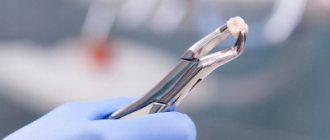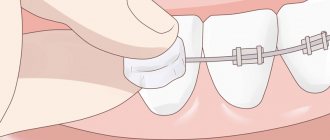Pain after CARIES treatment.
Normally, slight pain may occur when pressing on the filling.
, when a hard piece of food gets on the tooth while eating, or when running a fingernail or toothpick over the filling. Painful sensations more often occur after treatment of deep caries: the bottom of the carious cavity is close to the “nerve” of the tooth, and the placed filling, when pressed on it, transfers pressure to the tooth pulp. Over time, these pain sensations will decrease, because... The tooth pulp will develop a protective layer of dentin and “fence itself off” from the filling. However, this takes some time, and the discomfort when biting on a tooth can last up to several months.
Slight dull pain
in a tooth it can also be quite normal. In some patients, this is an individual reaction of the tooth to the doctor’s intervention (mechanical treatment of the tooth with burs, medicinal treatment with antiseptics, “exposure” of the filling with a halogen lamp, etc.). Such pain should not persist for more than 7–14 days.
Acute pain is not considered normal
, spontaneous (causeless) attacks of aching pain, especially at night. If you experience similar sensations after caries treatment, you should consult a doctor for an examination and, possibly, additional procedures.
If the filling is located in the cervical part of the tooth (near the gum), then the tooth may react to temperature stimuli
. In this case, it is important to pay attention to whether there is an overhanging edge of the filling in the gum area (i.e., a step or gap between the edge of the filling and the tooth). If such an unevenness exists, it can injure the edge of the gum, the gum can become inflamed and expose the root of the tooth. And, as you know, the root of the tooth is not covered with enamel and is very sensitive to any irritants. Therefore, if you notice that after treatment of cervical caries or wedge-shaped defect, the gums of the tooth become inflamed, and the tooth reacts to cold or sweet foods, then consult a doctor immediately.
Main mistakes in the treatment of periodontitis
The most common mistakes made during therapy are:
- Insufficiently thorough root canal treatment, when foci of infection remain and continue to destroy tissue.
- Incorrect opening of the hole at the root apex: incomplete opening, which does not ensure normal outflow of purulent exudate, or, conversely, opening with excessive pressure, when purulent discharge is pushed into the tissue surrounding the apex.
- Perforation of the root canal wall.
- Removal of filling material beyond the root apex.
- Incomplete delivery of the filling material - in this case, the material does not reach the apical foramen and “free space” remains for the further development of the infectious process.
- Incorrect assessment of the condition of the tooth: in some cases, the doctor decides to remove a completely viable tooth that is subject to therapy, in others, he tries to treat an obviously “dead” tooth.
As a rule, all of these treatment errors cause complications of periodontitis.
Pain after REMOVAL of a “NERVE” from a tooth (after treatment for PULPTIS).
Quite often, so-called “post-filling” pain occurs after tooth depulpation. Mild pain when pressing on a tooth is considered normal.
and tapping on it, lasting no longer than 4–8 weeks. This is due to the fact that during the treatment process the doctor performs mechanical treatment of the root canals with metal instruments and rinses the canals with powerful antiseptics. All this can irritate the tissue surrounding the root. The reaction to such influences is different for all patients.
If the pain when biting on a tooth is sharp, severe, there is a feeling of an “overgrown” tooth, swelling of the gums or cheeks around the tooth appears, general health worsens or body temperature rises - this is a reason to immediately consult a doctor. Complications of endodontic treatment may have arisen that need to be addressed.
Why does periodontitis start?
- As we have already noted, most often periodontitis is a consequence of untreated or poorly treated caries and pulpitis.
There may also be other reasons:
- Mechanical trauma and damage to the pulp, in which inflammation develops over time.
- As a complication of periodontal diseases.
- As a complication of rhinitis, sinusitis, osteomyelitis.
- As a consequence of weakening of the body, vitamin deficiency.
- As a concomitant disease with diabetes mellitus.
- As a result of poor oral hygiene and the presence of tartar in the cervical area.
Pain after treatment of PERIODONTITIS.
Sometimes it happens that the tooth never hurt, but the doctor diagnosed periodontitis and treated it, after which the tooth began to bother. In such a situation, do not rush to blame the doctor and believe that he provided poor-quality treatment.
Treatment of periodontitis is a very complex process that cannot promise guaranteed success. After all, periodontitis is an accumulation of microbes outside the tooth root (in the bone tissue). If before treatment microbes moved freely from the oral cavity to the tooth root and back, then after filling the canals, the bacteria remaining in the bone tissue are “immured.” Normally, this manipulation allows you to localize the source of infection, after which it is easier for the body to cope with it and “defeat” the microbes.
However, with a weakened immune system, due to the individual characteristics of the body, inflammation and a pain reaction may occur in response to sealing of the channels. Even if the tooth did not bother you before, now it can react to pressure and touching it; there may be pain when biting, throbbing, or a slight aching pain in the tooth.
Abnormalities include sharp, paroxysmal pain, the inability to close teeth due to pain, swelling of the gums or cheeks around the tooth, the appearance of tooth mobility, deterioration in general health, or a significant increase in body temperature.
In any case, if pain occurs, it is better to consult a doctor. Additional manipulations or the prescription of certain medications may be required. However, don't panic! Sometimes this kind of pain goes away on its own after some time.
Causes
Before you begin to eliminate the problem, it is necessary to determine the cause of the occurrence, depending on which the diseases are distinguished:
- Traumatic - occurs when there is a mechanical action on the jaw, such as a blow, bruise, or even getting hit by a bone when eating food. Also with regular small impacts, such as biting off threads.
- Medication - in case of non-compliance with the doctor’s visit schedule: sometimes a strong medicine is placed in the root canal, and the next appointment time is not just prescribed. Ignoring it leads to acute periodontitis.
- Infectious - the culprit is streptococcus, which accumulates in the affected tissues and provokes inflammation.
Among the ways of “infection” there are:
- intradental - or canal, that is, toxins and bacteria move through the root canal, infect the pulp and lead to death in the periodontal tissues;
- extradental - less common - inflammation spreads from surrounding tissues not directly related to the dentition - sinusitis, osteitis, etc.
Even less often, the transition occurs through blood and lymph.
Pulpitis and periodontitis are often confused, but:
- first - inflammation, which occurs due to the penetration of microbial organisms, affects the pulp - the inner part of the tooth, where the nerve endings and blood vessels are located; characteristic symptoms are acute throbbing pain, which sometimes spreads to the ear, jaw, head (causing migraine), and intensifies in the evening and with a sharp change in temperature;
- second, the inflammatory process affects the deep bone tissues surrounding the tooth and is a complication after pulpitis.
That is, the second is a consequence of the first.
Classification of periodontitis
The pathogenesis of the disease distinguishes several types:
- Apical periodontitis is considered a mild form, localized at the very apex of the root, with symptoms: acute pain, swelling, high body temperature and malaise. The causes are untreated pulpitis or carious disease, an error when installing a prosthesis, and even tartar. This type accounts for thirty percent of requests.
This disease is typical for an undistributed load on the teeth, which take on the role of removed molars or fillings, and also occurs due to therapeutic errors.
- Granulating periodontitis - characterized by pain when pressing, a feeling of swelling of the tooth, as well as skin fistulas - a purulent formation opens in the epithelium under the tooth, through which a variety of formed bacteria tries to find a way out. It can be effectively treated if you visit a dental clinic in a timely manner.
- Granulomatous (purulent) periodontitis is a dangerous pathology, which is characterized by the absence of pain symptoms that prompt the patient to see a dentist, since this is how the body protects itself from harmful microorganisms entering the blood. In this case, tooth and bone destruction occurs, and the tissues are filled with granulomas. Ultimately, this leads to tooth extraction without the possibility of restoration.
Additional information: A granuloma is a neoplasm formed from granulation tissue that isolates the affected, inflamed areas from the rest of the body. This is a kind of pouch filled with decaying cells. The capsule is usually attached to the root of the tooth and causes its loosening and destruction.
- Fibrous periodontitis - like the purulent form, cannot be diagnosed in the early stages, as it is almost asymptomatic. This is a constant inflammation of the periodontium (that is, the connective tissue that surrounds the tooth surface). In this case, the ligaments that hold the tooth in the gum are disrupted, which can lead to loss of teeth.
At the same time, this form of the disease can be caused by both independent factors, for example, problems with the heart and vascular system, and single causes:
- infection of periodontal tissues;
- deep advanced caries;
- mechanical impact and injury;
- low quality filling or prosthesis;
- chronic granulating or granulomatous periodontitis;
- penetration of foreign substances into the gums (pin, instrument defect).
Complications
Exacerbation of periodontitis, depending on the form of tooth damage, the stage of the disease and the location of the affected tooth, leads to complications:
- periostitis - inflammation of the periosteum or jaw;
- abscess - the development of an abscess due to the destruction of mucous, skin and fascial tissue, while neoplasms are characterized in soft tissues;
- phlegmon - abscess rupture;
- sinusitis - transition of the inflammatory process to the maxillary sinus;
- lymphadenitis - enlargement of the lymph nodes located closest to the affected area of the jaw;
- osteomyelitis - spread of infection to the bone, periosteum, soft tissue.
In addition to inflammatory processes, secondary adentia can occur - when, due to delamination of bone tissue, the tooth simply stops receiving nutrition and functioning and falls out.
Exacerbation of chronic periodontitis, as a rule, does not manifest itself symptomatically in the early stages of the disease, so it can only be detected during a preventive examination using x-ray diagnostics. Teeth that have previously undergone treatment for pulpitis or complex caries must undergo this type of examination.
Early diagnosis
An important role in making a diagnosis is an accurate, complete anamnesis - a survey (questionnaire) of the patient regarding complaints, the nature of pain, medical history and previous surgical interventions in the oral cavity.
Absolute indications for electroodontodiagnostics and x-ray examination:
- pain in a tooth that has previously been treated;
- state of intoxication of the body - high temperature, weakness, lack of appetite;
- the presence of asymmetry of the oval of the face, neck, change in skin color, enlargement of the lymph nodes closest to the jaw;
- external changes in the oral mucosa;
- the presence of a deep periodontal pocket;
- an extensive filling, under which the development of caries disease is observed (“a bad” filling can be easily identified by color, even if it is not photopolymer; as a rule, the affected materials have a gray color, under which darkening of caries is observed);
- tooth mobility.
Important! A diagnostic method based on the use of electric current allows one to determine the pain threshold of the dental pulp to determine its viability and the level of damage.
Light mechanical manipulations are also used to make a diagnosis - tapping in several positions (allows you to accurately determine the affected canal). It is also possible to use a cold test.
If at least one of the signs of periodontitis is detected, the diagnosis moves to the X-ray level. For accuracy, modern dentistry uses computed tomography, where each tooth is visible in great detail.
The exact type of disease can be determined directly during surgery, so contact a professional clinic where there will be specialists and tools to eliminate and treat this disease. .
Forms of periodontitis and their symptoms.
There are two main forms of periodontitis and it is important not to get confused by their symptoms, because some of them are insidious:
- Acute periodontitis.
Acute periodontitis can begin sluggishly and unnoticeably.
Then the symptoms begin to increase, and as acute inflammation develops in the periodontium, the following symptoms appear:
- Aching pain that intensifies with pressure and gradually becomes unbearable.
- Reaction to hot food.
- Swelling of the gums and/or cheeks.
- “Big tooth” syndrome, in which the patient feels that the tooth has “increased in volume” and is protruding from the dental arch.
- The tooth becomes mobile in the socket.
- A fistula may form to drain pus.
- General intoxication of the body - temperature, fever, headache, leukocytosis.
A feature of acute periodontitis is that it is not determined by an x-ray, because at this stage of the disease there are no characteristic changes in the periodontal fissure.
- Chronic periodontitis
Chronic periodontitis develops latently, there is no pronounced tissue inflammation, it develops gradually. This form of the disease is dangerous because the symptoms of chronic periodontitis are virtually absent, and at this time tissue damage progresses and irreversible processes occur in them - atrophy of the tooth socket, tooth loosening, formation of cysts and granulomas.
The main symptoms of chronic periodontitis are:
- Heaviness.
- Feeling of fullness.
- Discomfort when chewing on the affected side.
In addition, from time to time chronic periodontitis can worsen, and then it is characterized by the same symptoms as the acute form.
Very often, chronic periodontitis is diagnosed incidentally using an x-ray, usually taken for another dental problem.
We would like to add that the earlier periodontitis is diagnosed in a patient, the higher the likelihood of complete recovery and preservation of the tooth, even without the use of surgical treatment methods.
Symptoms of periodontitis
- pronounced swelling of the tissues, not only of the gums, but also of parts of the face - in the place where the diseased tooth is located,
- painful sensations: the pain becomes more acute when touching and mechanical impact on the tooth - occurs during the acute course of the disease,
- mild pain with unpleasant sensations in the chronic course of the disease: a feeling of heaviness, tooth bursting,
- a hole (fistula) may form on the gum, through which pus comes out,
- increase in body temperature.
Periodontitis can be acute or chronic; in the second form, the symptoms are not so pronounced. It is worth noting that periodontitis differs from pulpitis in the absence of pronounced pain in the tooth itself, since the nerve has already become necrotic and, in fact, there is nothing to hurt here. Therefore, treatment of the disease in many cases can be carried out even without the use of anesthesia, especially if we are talking about a chronic form, because in this case, the nerve has been in a lifeless state for a very long time.
Exacerbation of periodontitis: symptoms and treatment
Most often, chronic periodontitis is detected during exacerbations. It is even often initially mistaken for an acute form, but additional signs revealed by studying x-rays and the patient’s condition make it possible to establish an accurate diagnosis.
The main symptoms of exacerbation of chronic periodontitis are in many ways similar to those observed in the acute form of the disease, and the treatment regimen in both of these cases is the same. It is carried out in several stages.
At the first visit, the doctor opens the pulp chamber and removes the nerve, after which he thoroughly cleans the canals and cavity of the tooth, creating conditions for the outflow of pus. After this, the exposed tooth must be rinsed for several days with a soda solution in order to wash out the remaining purulent masses.
During the second visit, medications are placed into the canals and the cavity of the tooth, which are closed with a temporary filling. The aching tooth is left in this state for 1-2 weeks.
After this, if the control image does not cause alarm, the temporary filling is replaced with a permanent one.
In some cases, exacerbation of chronic periodontitis makes itself felt after completion of treatment. To relieve its symptoms, anti-inflammatory therapy is prescribed, which can be supplemented with physiotherapeutic procedures.
Treatment methods
Treatment of periodontitis is a very long process that requires several visits to the dentist and x-ray control at all stages. The essence comes down to clearing the canals from the source of infection and placing the drug inside the tooth, installing a temporary filling - this procedure is repeated several times until the inflammatory process is completely stopped. At the same time, drug therapy is prescribed. Next, the canals are filled and, if necessary, an inlay or crown is installed to restore the apex of the tooth.
Treatment of dental canals In case of periodontitis, as in pulpitis, a thorough cleaning of the dental canals is carried out - endodontic treatment. But if in case of pulpitis the cavity can be filled almost immediately, then in case of periodontitis anti-inflammatory and antibacterial drugs are injected into the canals, more than once. The process is controlled by x-ray examination. Only after the source of inflammation has been completely eliminated can the canals be filled. The cost of treatment directly depends on the number of roots of the tooth.
Price:
from 8,500 rubles more about the solution
Installation of a core inlay If the tooth crown is severely damaged and it is impossible to place a classic composite filling, you will need to build up the tooth and at the same time strengthen its root. One of the best options is to install a stump tab. It differs from a pin in that it is created strictly individually, that is, it completely replicates the structure of the root system of the tooth. Afterwards, you can build up the top with composites or install a crown.
Price:
from 5,000 rubles more about the solution
Installing a crown It may be necessary to place a crown on a tooth if its top is severely damaged. But first, most likely, the tooth will need to be strengthened, because an artificial crown requires some kind of foundation. The prosthesis can be made of various materials: metal-ceramics for the sides, solid ceramics for the front, or zirconium dioxide for any group of teeth.
Price:
from 11,000 rubles more about the solution
Is it painful to treat periodontitis?
When treating periodontitis, local anesthesia is used - conduction or infiltration. Modern drugs allow you to completely eliminate pain during use. Our patients do not even feel the injection of anesthesia - we numb the injection site by applying a special anesthetic gel (application anesthesia).
To reduce pain after administration in the treatment of an acute form of the disease, which is characterized by severe pain, painkillers are prescribed until the inflammation subsides.











